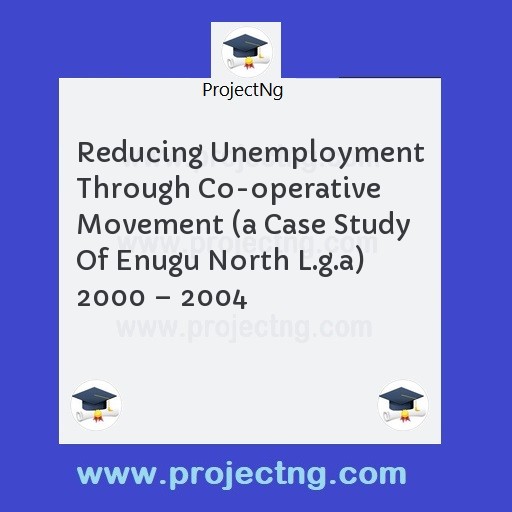Reducing Unemployment Through Co-operative Movement (a Case Study Of Enugu North L.g.a) 2000 – 2004
Cooperative Economics Project Topics
Get the Complete Project Materials Now! »
REDUCING UNEMPLOYMENT THROUGH CO-OPERATIVE MOVEMENT (A CASE STUDY OF ENUGU NORTH L.G.A) 2000 – 2004
ABSTRACT
The study was conducted to examine how unemployment has been reduced through cooperative movement in Enugu North Local Government Area, from the year 2000 – 2004.
In the course of this investigation, research objective and hypothesis were formulated. Both primary and secondary data were collected, and data were then presented in a tabular form.
Based on the above, the findings on the topic is as follows:
Staff/employee of the sampled cooperative are averagely qualified for their various jobs and they are given opportunities for further training by the cooperative societies.
Employee of the sampled cooperative are averagely paid with some necessary allowances.
Co-operative societies absorbs about 35% of school leavers yearly.
There is a continuous education both to the members and the whole public.
The researcher’s recommendations includes these:
Government should make it compulsory for every establishment to have its own cooperative.
Government should set up more cooperative banks to give loans to individuals and groups that are prospecting to establish cooperative.
In conclusion the researcher deemed it necessary that every hand must be on desk to encourage the establishment of cooperative enterprises, since it is now obvious that the only option left for us is to adopt the socio- economic model of mutual self help.
TABLE OF CONTENTS
TITLE PAGE i
APPROVAL PAGE ii
DEDICATION iii
ACKNOWLEDGEMENT iv
ABSTRACT v
CHAPTER ONE
1.0 INTRODUCTION
1.1 BACKGROUND OF THE STUDY
1.2 STAZTEMENT OF THE PROBLEM
1.3 OBJECTIVE OF THE STUDY
1.4 SIGNIFICANCE OF THE STUDY
1.5 RESEARCH QUESTIONS
1.6 SCOPE AND LIMITATIONS OF THTE STUDY
CHAPTER TWO
2.0 LITERATURE REVIEW
2.1 DEFIINITION OF UNEMPLOYMENT
2.2 TYPES OF UNEMPLOYMENT
2.3 CAUSES OF UNEMPLOYMENT
2.4 PROJECTS CO-OPERATIVE CAN INVOLVE IN
2.5 BENEFITS OF CO-OPERATIVE SOCIETY
CHAPTER THREE
3.0 RESEARCH DESIGN AND METHODOLOGY
3.1 SOURCES OF DATA
3.2 PRIMARY SOURCES
3.3 SECONDARY SOURCES
3.4 POPULATION OF STUDY
3.5 DETERMINATION OF SAMPLE SIZE
3.6 METHOD OF DATA ANALYSIS
CHAPTER FOUR
4.0 PRESENTATION AND ANALYSIS OF DATA
CHAPTER FIVE
5.0 SUMMARY OF FINDINGS, RECOMMENDATIONS AND
CONCLUSION.
5.1 SUMMARY OF FINDINGS
5.2 RECOMMENDAITON
5.3 CONCLUSION
BIBLIOGRAPHY
APPENDIX.
CHAPTER ONE
1.0 INTRODUCTION
1.1 BACKGROUND OF THE STUDY
Co-operative is a basis for overall transformation of citizenry social and economic problems.
According to Berko (1987 :29), co-operative society is a voluntary and democratic association of persons, with variable membership and variable capital whose members pooled themselves and their resources together on mutual and self help basis to form a business enterprise which seeks to solve the socio-economic problem(s) of these members by directly providing goods and services to them in their capacity as either the owner/customer or owner – employees of the cooperative enterprise.
According to Amahalu (2005 :2), cooperative is defined as an association usually incorporated with economic aims, formed by or for persons or co operations, having common needs, approximately equal voice in
Be the First to Share On Social

Enjoying our content?
Don't miss out on new videos! Subscribe to our YouTube channel for more awesome content.
Subscribe Now!













